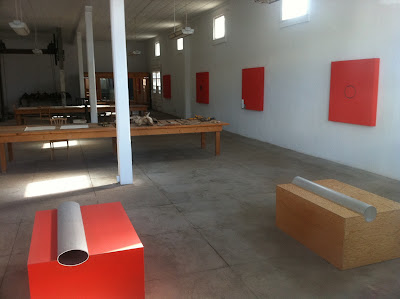Art as backdrop.....
Today, I decided to pay one more visit to the de Kooning retrospective at the MoMA before it closes for good next week. Having lived here for over 20 years, I know that the MoMA has become almost impossible to visit except on Tuesdays when it is closed to the public and various art educator events go on. I have been to crowded museums in many places, but what I witnessed today was unprecedented--artwork being manhandled by adults and children and guards letting it happen.
Apparently the MoMA has no limits on how many people can be jammed into their $25 carnival of Modern Art. Yankee fucking Stadium has a seating capacity. Does the MoMA have a limitless capacity? Are there no fire marshals? The world's greatest collection of Modern Art is being presented in the most crass, disgusting anti-art atmosphere I have ever seen. The noise level is unbearable, the screaming children omnipresent and every artwork a mere photo op. The trustees and directors of this museum should be ashamed of themselves. This museum is a shithole. Period.
Problem number one is that they place no limits on the amount of visitors because all they care about is making that $25 dollars, not making sure that the kind of care and time and talent that went into producing many of the works on view deserves some kind of reciprocal respect. I'm sure Ronald Lauder is never around when the rabble is present. How much money does the museum have to generate? Is all the money going to the poorly paid clerks and guards?
Problem number two is that the Museum thinks that its good for business to have every tourist snapping pictures instead of looking at the art. It's not even that they are taking pictures so much as taking pictures of themselves with the artwork. Every artwork is a photo op. The great Pollock painting above was just a backdrop for a slew of pretty girls to pose and mug and post the pic on Facebook asap. This is the culture we live in. Technology giveth but it taketh awayeth a lot. Pity the poor soul who trekked in from Sydney on his first trip to the United States to view his favorite artist Jackson Pollock.... All photography should be banned at the museum. Take a picture of yourself outside the museum in front of the MoMA sign.
Worse than anything I have described was the rampant touching of the artwork by museum visitors. I verbally castigated a guard who was asleep at the wheel as usual as a Judd brass box was finger pawed by several children. That work always looks like its been treated like shit and the Judd Foundation should have it removed from the museum. A Lee Bontecu relief became the source for much amusement and was banged several times by visitors posing in front of it. The worst treatment of all was reserved for a recent acquisition, a De Wain Valentine 1966 fiberglass/polyester sculpture and gift from Marie Josee and Henry Kravis last year (see photo above). Unfortunately, the museum doesn't think too much of that gift since it lets passerby after passerby cop a feel. I saw at least 5 people in 15 minutes touch it as they walked by. One hapless guard can't see everything. Eventually this beautiful gleaming example of West Coast Minimalism brought to the New York art world's attention by Tim Nye will look as shabby as the Judd does.
That's why Donald Judd left for Marfa. He knew that museum people didn't ultimately care about the preservation of artworks so much as the preservation of their careers. I will be writing at length about Judd's vision in Marfa in the coming weeks but the man cared more about art than the trustees of the MoMA and the people who run the museum. I used to lament that Dia:Beacon was 90 minutes from the City, but now I see that as one of its great strengths. Keep the art as far away from the people as possible. That's the only way it will physically survive unless a whole new set of policies are put in place.
I was amused by how the the curators decided to mix things up a bit and so I saw LOTS of work by Marcel Broodthaers and Daniel Buren from the newly acquired Daled Collection. This dreary assortment particularly by the supremely overrated French hack Daniel Buren was the one empty gallery in the entire museum. Yes, it was those tarps of stripes that the Octoberists masturbate to. Lots of snickers at the sublime Ryman painting Twin 1966, though. That one had people wondering WTF. But it's easily one of the 10 best works in the entire museum. I can also say that I finally saw a Lawrence Weiner work that was great--a drywall cutout and a Robert Barry piece from 1968 that looked a little too much like a Fred Sandback for comfort. It's too bad that we can't see work here in New York by the only great artist produced by the whole Institutional Critique genre--Michael Asher, instead we get Broodthaers and Buren who are like double doses of chemotherapy.





